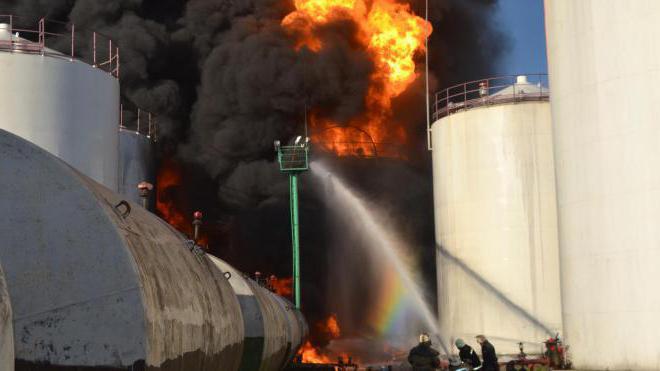On January 1, 2012, Federal Law No. 225 “On Compulsory Insurance of Liability of the Owner of a Dangerous Object” (OPO) entered into force. It regulates the relations of legal entities, individual entrepreneurs and determines the responsibility for causing harm to the life and health of victims of an accident that occurred at any facility in the Russian Federation.
Background
Mandatory liability insurance The owner of the hazardous facility was not accidentally introduced. The reason was several large emergency situations that resulted in damage to people. The most notorious is the incident that occurred on December 3, 1984 in Bhopal (India) at Union Carbide enterprises. The explosion killed 18 thousand people, of which 3 thousand died on the spot, and the rest died in subsequent years. The total number of victims is 600 thousand people.

One of the consequences of such accidents was the introduction of insurance of hazardous facilities. In the Russian Federation until 2012, the process was regulated by law No. 116 "On the industrial safety of hazardous production facilities." Now a new regulatory act has been introduced.
An object
The provisions of the law apply to:
- Hazardous production facility, the operation of which is at least partially carried out at the expense of state funds. At such workplaces, hazardous substances are produced, processed, transported and stored. The equipment operates under excessive pressure of steam, gas (0.07 MPa), water (115 C), and other liquids (0.07 MPa).
- Elevators and escalators in high-rise buildings.
- Waterworks (dams, power plants, tunnels, canals, locks, ship elevators, erosion control devices).
- Gas station of liquid fuel.
The owners of such facilities must, at their own expense, take out insurance for hazardous facilities for the entire duration of their operation.

OPO are divided into 4 types:
- extremely high hazard class;
- high level of danger;
- intermediate level;
- low hazard facilities.
Effects
In the absence of an agreement, the following measures are provided:
- a fine in respect of the owner of the POE in the amount of 300-500 thousand rubles;
- a ban on the operation of the facility until the policy is issued;
- the possibility of making regression requirements;
- transferring part of the prize to the treasury of the Russian Federation.
Nuance
Let us consider in more detail the differences between Laws No. 255 and No. 116 “On Industrial Safety of Hazardous Production Facilities”:
- payment amounts increased to 6.5 billion rubles .;
- the maximum amount of compensation for one victim is 2 million rubles;
- the new law defines the term “accident” - this is the event after which the insured event occurs;
- money is paid after violation of living conditions;
- for each day of delay in payment of compensation, a penalty of 1% of the amount is provided.
Compulsory insurance of hazardous facilities
The maximum damage from an accident in Russia is 100 billion rubles. in year. In this case, harm will be caused to the environment, enterprises and individuals. TSO insurance can cover 30-40% of the damage. On the territory of the Russian Federation there are more than 230 thousand enterprises representing a threat. All of them must insure liability for damage to health and property. The amount is calculated using special coefficients and depends on the object.
Despite the growth of the market, there are not many companies that can really take out insurance for hazardous production facilities. But the law contributed to the opening of a new niche in the market.In 2012, the National Union of Insurers (NSSO) was created, which controls the new direction, as does the RSA. It includes 23 companies with experience in industrial insurance.

Only participants with two years of experience in the voluntary liability insurance market, with branches in at least 7 regions and a total amount of more than 1 billion rubles, will be able to work in this segment. The amounts of payments are large, so most organizations will not take such risks. The creation of the NSSO will also help to avoid a situation where small players in the market, not in pools, sell policies at a price lower than regulated by law.
Differences
Mandatory insurance of hazardous facilities has a number of features in relation to other areas:
- The government has established uniform tariffs. Therefore, it is impossible to find an insurer who would offer special conditions for acquiring a policy.
- Liability insurance of the owner of a public liability insurance company can be dealt only by companies included in the NSSO. There are only 40 of them. At the same time, insurers have the right to monitor the technical condition of objects.
- The contract is concluded for each object for a period of at least one year. In support of the transaction, an insurance policy is issued. It is issued on "orange" forms. They are pre-printed for members of the NSSO.

Insurance Organization
The amount of compensation depends on the type of object. If the company provides for the development of a safety declaration, then the scale of the possible number of victims is applied. So, for example, if more than three thousand people can suffer as a result of an accident, then the amount of payment is 6.5 billion rubles:
- 1 billion rubles - up to 3 thousand people;
- 0.5 billion rubles. - up to 1,5 thousand people;
- 0.1 billion rubles. - up to 300 people;
- 0.05 billion rubles. - up to 150 people;
- 0.025 billion rubles. - up to 75 people;
- 10 million rubles - up to 10 people.
If there is a development of the declaration, then the amount of compensation is calculated according to the following conditions:
| Object Types | Amount, million rubles |
| Hazardous production facility in the oil refining and chemical industries | 50 |
| Gas supply networks | 25 |
| Other objects | 10 |
Insurance rates for all companies are approximately the same. They depend on the class of the object and range from 0.05-5% of the limit. The premium is paid in installments. The contract comes into force from the moment the first installment is credited. In case of violation of the payment terms for more than 30 days, the company may demand termination of the contract.
Insured event - the occurrence of civil liability for obligations that arose as a result of harm to victims, as a result of which compensation is due. A case is recognized as such if:
- The infliction of harm was the result of an accident that occurred during the contract period. The damage caused by several victims is the result of one insured event.
- The accident took place at the HMO.
Sequencing
- The owners of the POE should identify objects.
- Prepare data characterizing the maximum damage from the accident.
- Objects registered before 03/15/13 must be reissued with a view to assigning them hazard class.
- Choose a company and arrange liability insurance for hazardous facilities.

To conclude a contract, you must provide:
- statement;
- a copy of the certificate of registration of the GRO;
- copies of documents of ownership;
- information about the OBO.
Liability insurance of hazardous facilities provides for the payment of compensation:
- physical persons whose life and health were damaged;
- legal entities whose property was harmed.
Compensation
To receive payment, the victim must provide the insurer:
- statement;
- passport (copy of constituent documents);
- documents proving family ties with the victim or confirming the credentials of persons at the enterprise where the accident occurred;
- an act or medical certificate confirming the infliction of harm to life and health or property.
Insurance payment is made by cash or bank transfer.The company is obliged to transfer funds or provide a reasoned refusal within 25 days from the moment of establishing the causes of the accident and receiving a full package of documents.

Tariff Changes
In July 2015, the Central Bank prepared a project to reduce tariffs by 2 times for most facilities. The reason for the innovations is the imbalance of fees and payments. Over the period of the law, insurers receive billions, and pay very small amounts: 4-7% of the annual premiums. But three years of history is not a long time to draw conclusions about the adequacy of the amount of tariffs, since the quantity insurance claims very small. Fortunately, accidents occur 2-3 times a year. The previous maximum payout limit of RUB 6,500 million, following the results of 2014, reached the level of general fees. Insurance of hazardous facilities is socially significant. Therefore, it was decided to review the terms of transactions.
Starting September 1, 2015, new tariffs for the owners of public utilities came into force. The growth of premiums for mines and hydraulic structures amounted to 1.5-2.5 times. But for the owners of the remaining facilities, the price has been reduced. According to analysts, the new instructions of the Central Bank will lead to a reduction in fees in 2016 to 3.5 billion rubles. Compulsory insurance of hazardous facilities is expensive for industrialists. Therefore, most of them were satisfied with such innovations.
Earlier, the Ministry of Finance prepared amendments to the law on increasing insurance amounts 10 times for owners of certain categories of objects, for example, mines. But the project was not introduced. Therefore, tariffs have been developed that are feasible for the real sector of the economy. Insurance of hazardous facilities is not unprofitable. But this is more likely due to the underestimation of the number of accidents by the owners. The maximum payout is 3.5 billion rubles. But companies still have insufficient financial stability to withstand two maximum payouts.
Statistics
As a result of innovations, fees will be halved in 2016 - to 3-3.2 billion rubles. The reason is not only tariffs, but also a change in safety factors (0.6-1.0). The maximum discount on insurance contracts is 40%.
Reinsurers are mainly involved in transactions in hydraulic facilities. Their innovations will hardly affect. Objects with lower limits are reinsured within the NSSO. There should not be problems there either. But for small companies, the profitability of transactions can become negative. Therefore, the pool capacity will change.

Every year, the NSSO collects information about which of the participants intends to continue work. As the market structure changes, the share of large players grows. So, in 2014, the Top 5 companies owned 65% of the assets, in 201 - 68%.
To work in this segment, you need to bear fixed costs. First of all, these are membership fees. If they decrease, then managers calculate cost-effectiveness. Now the volume of premiums may decrease due to changes in tariffs. Therefore, the issue of profitability will again become relevant.
In practice, there have already been cases where victims tried to recover amounts more than they should be, but they are single. And almost always the court took the side of the insurer. In this type of service, all the nuances are prescribed in the law and in the table on tariff calculation. Therefore, attempts by customers to recover large sums do not bring success.
